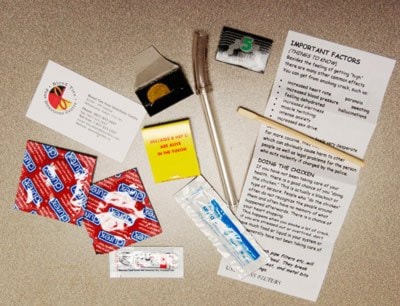While federal Tories threaten to force downtown Vancouver drug addicts out of a safe injection site and back onto the streets, three Whitehorse-based organizations are collaborating to launch a harm reduction network for Yukon.
The new network, comprised of Blood Ties Four Directions, Many Rivers Counselling and Support Services and Fetal Alcohol Syndrome Society of Yukon, was formed to “promote the health and dignity of individuals and communities impacted by substance abuse,” said a release from the groups.
“We do have a population of people in Whitehorse who use drugs, and they tend to be an underrepresented, misunderstood, often maligned, stigmatized community,” said Blood Ties executive director and network chair Patricia Bacon at a news conference on Thursday.
“Not everyone is in a position to just give up and abstain from using,” added Marilyn Wolovick, executive director of Many Rivers. “We feel it is a human right to have access to harm reduction.”
But public and political sympathy may be a tough sell amid threats to close downtown Vancouver’s safe injection site, Insite, and renewed calls to get tough on drug use and its related criminal activity.
The Canadian government wants to get people off drugs, said a spokesperson from federal Health Minister Tony Clement’s office, after the minister toured Insite last summer.
However, it is crucial the Canadian public and elected politicians do not hold administrators of harm reduction responsible for prevention of drug use, said Bacon.
“Harm reduction programs are not meant to stop people from using drugs,” she said.
“It’s not the goal.”
All three organizations already provide an array of harm reduction services, such as the distribution of free condoms, clean needles, and, via the No Fixed Address outreach van, food, water and warm clothing for people on the streets.
More recently, a growing use of crack cocaine spawned the demand for “safer crack kits.” Since 2005, up to 600 have been distributed monthly in Whitehorse.
The controversial kits each contain a glass pipe, a vinyl mouthpiece, lip balm and brass screens to prevent the lung damage that often results from homemade alternatives.
“When they smoke the pipes, they have to use a filter,” said FASSY spokesperson Lilliam Sequeira, whose clientele also struggle with fetal alcohol spectrum disorder.
“But they don’t have the money to buy those. They use Brillo (pot scrapers). When that decomposes, it goes into their lungs. Some of it sticks in their throats.
“We had to teach them a better way of smoking the pipe that is safer.”
Blood Ties has also offered programming such as street first aid, instruction for users on how to help themselves and others in cases of overdose, assault, or other potentially deadly situations that can be part of the street life routine.
The program was well received by a small number of drug users, said Bacon.
Although the network hopes to engage those most affected, it is unlikely they and their contemporaries will form an organization like VANDU, the Vancouver Area Network of Drug Users.
These groups are much more successful in larger cities, where users can be assured of greater anonymity.
Instead, the Yukon network will need to find its own methods to reach users in Whitehorse and the communities, said Bacon, whose organization distributed 70,000 syringes to intravenous drug users last year.
“Introducing harm reduction programs can be complicated,” she said.
“You don’t just march into, say, Burwash Landing and start handing out crack pipes.”
The network’s goal will be to advocate for more programs, education and capacity, and to resist the federal government’s tendency to cut from an already scant budget for harm reduction.
“The network intends to hold governments accountable for adequately funding programs,” said Bacon, noting only five per cent of the money spent on the war against drugs is put toward prevention, education, harm reduction, or any other programming apart from enforcement.
The group plans to implement programs to target youth, who may be averse to accessing existing services, women and prisoners, who, despite prevalent drug use and tattooing, are given virtually no opportunity for harm reduction.
The public tends toward vilification because if it examines the issue closely, the aggravating factors of drug abuse demand social action, said Bacon.
“I think we tend to want to always hold the individual accountable and we tend to not want to take a broader social lens to things.
“If you have diabetes, it’s your fault, it’s your poor diet, your poor choices. If you’re using drugs and then you get HIV, that’s your fault, that’s your poor choices.
“Drug use is complicated.
“What are we doing about poverty? What are we doing about the shrinking middle class in Whitehorse, and the fact that we’re seeing a more and more polarized community?
“We don’t want to address that.”
If users are given help in safeguarding their health, it can lead to cessation of drug abuse, she said.
